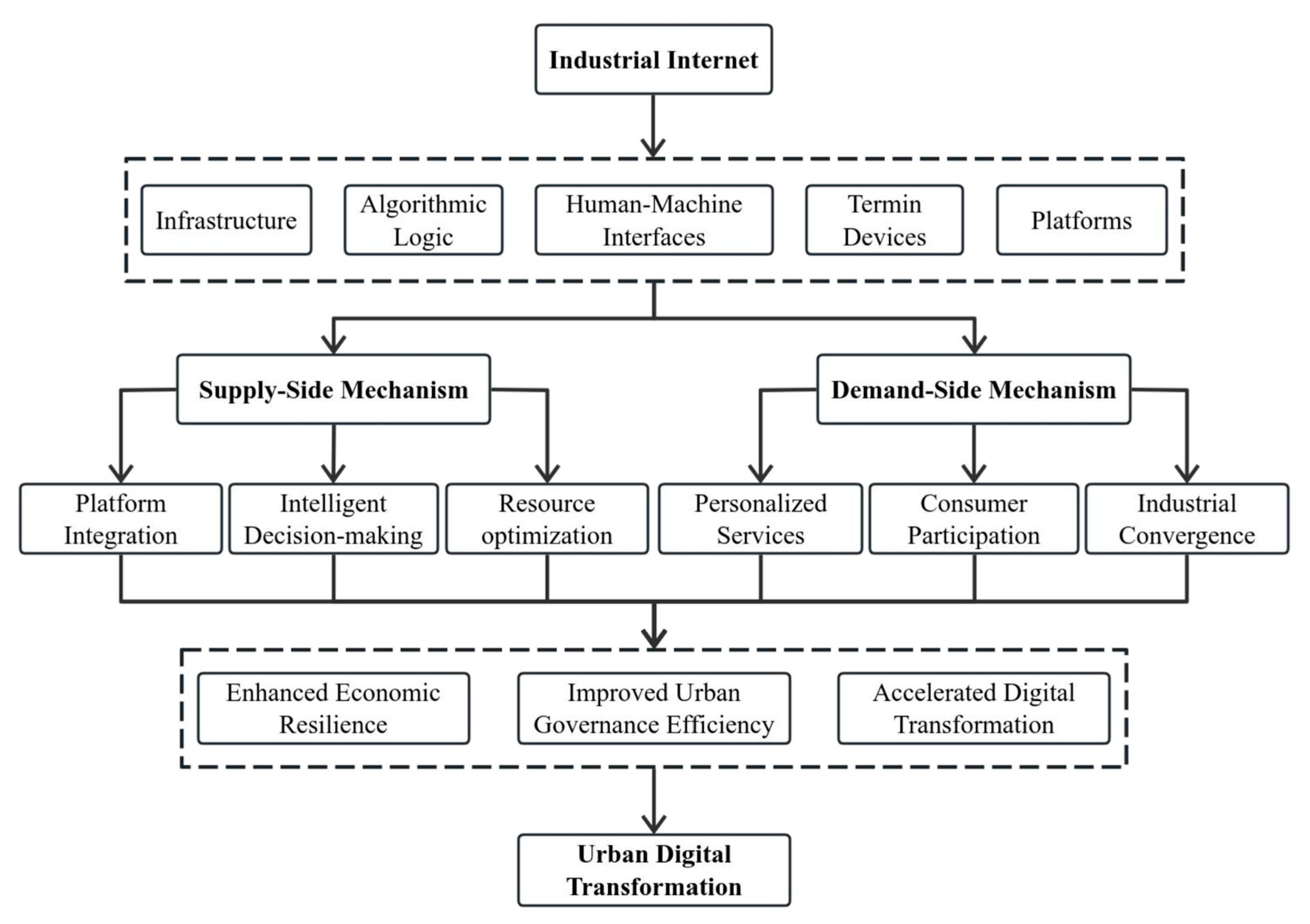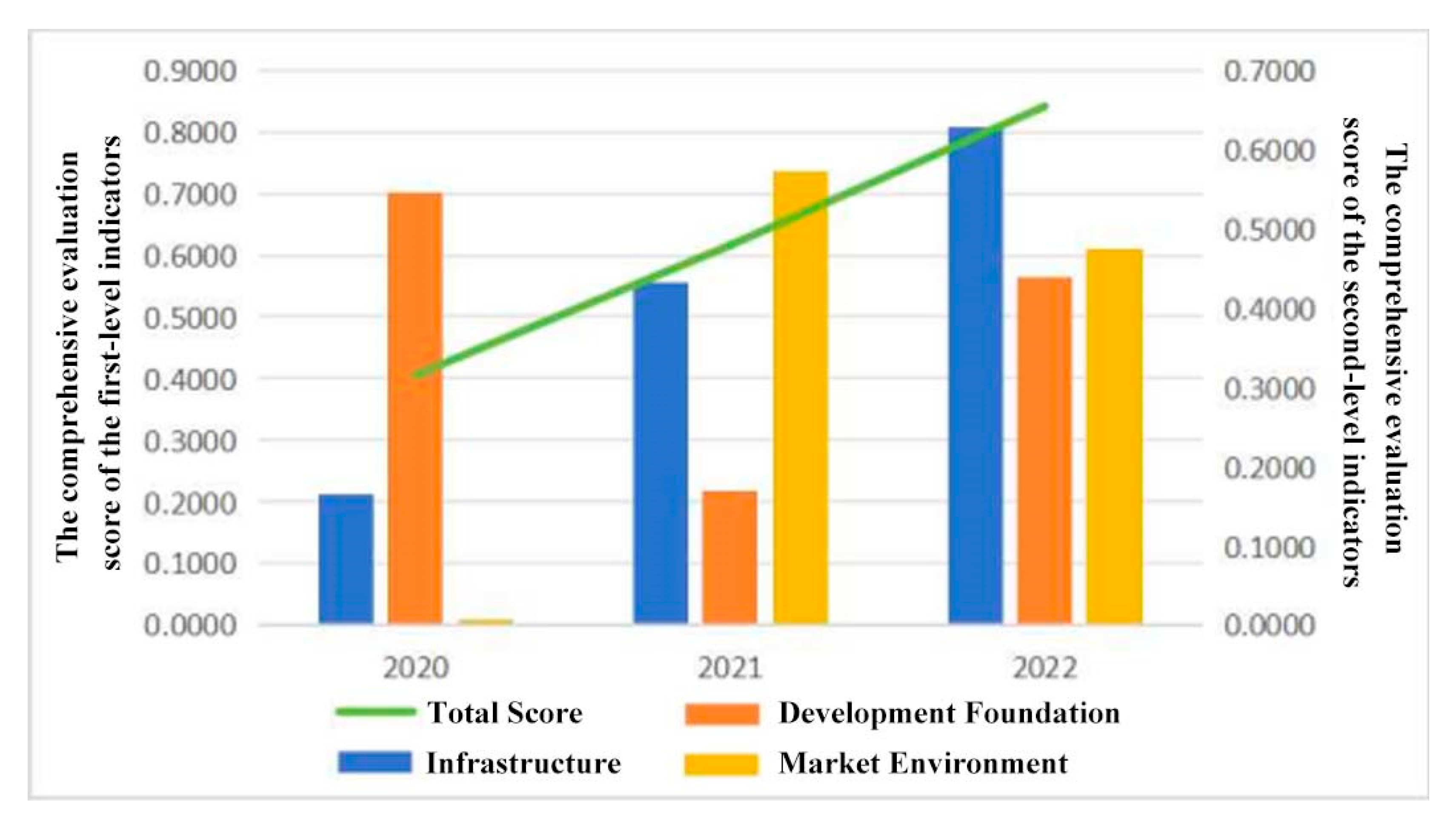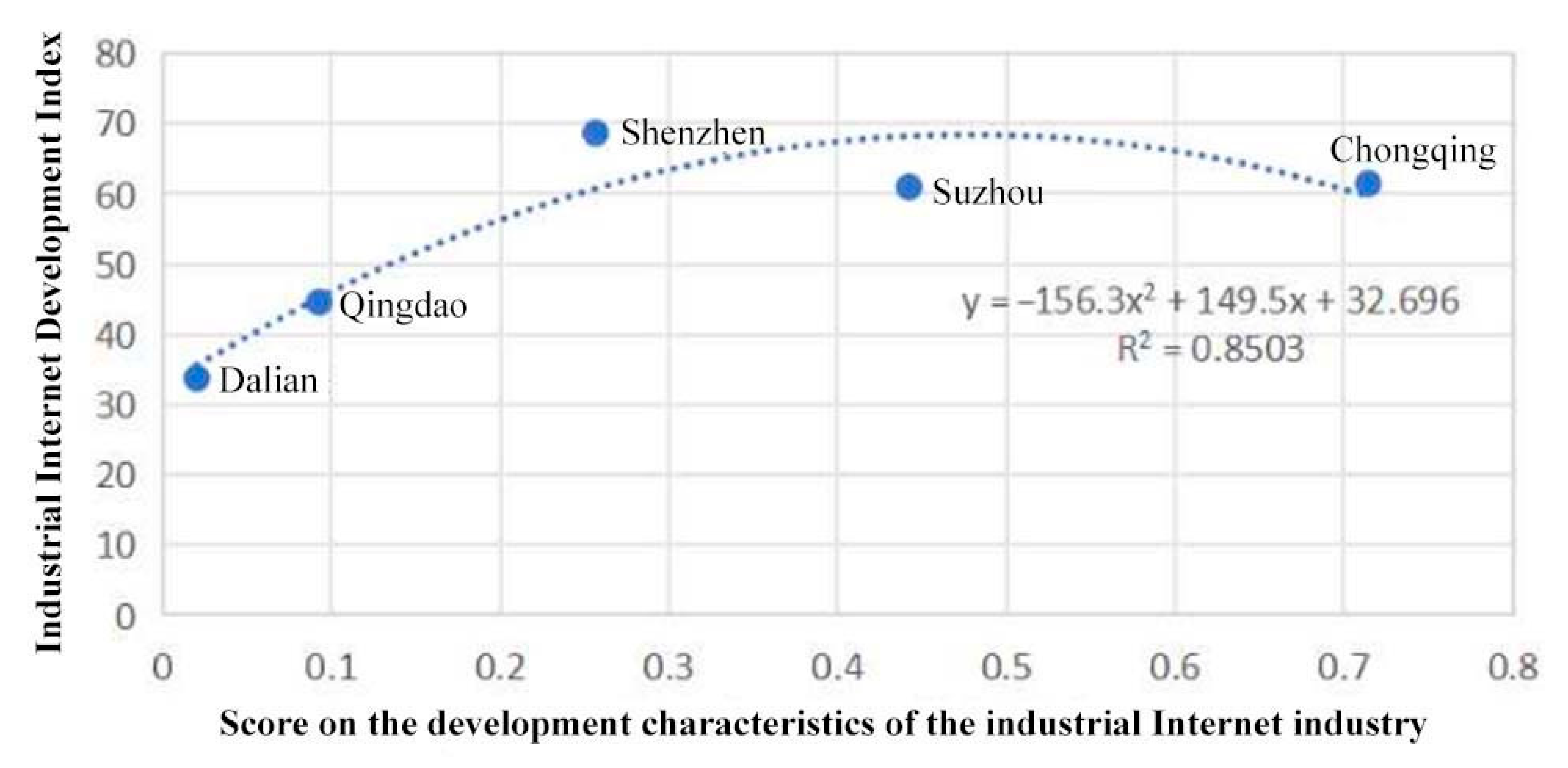A Systemic Pathway for Empowering Urban Digital Transformation Through the Industrial Internet
Abstract
1. Introduction
2. Literature Review
3. Theoretical Framework and Research Hypotheses
3.1. Mechanisms of the Industrial Internet in Empowering Urban Digital Transformation
3.1.1. Supply Side Mechanism
3.1.2. Demand-Side Mechanism
3.2. Heterogeneity in the Empowering Effects of the Industrial Internet
4. Materials and Methods
4.1. Construction of Indicator Systems
4.1.1. Evaluation System for Industrial Internet Development
4.1.2. Evaluation System for Industrial Internet Industrial Characteristics
4.2. Data Sources
4.2.1. Industrial Internet Development Data
4.2.2. Industrial Internet Industrial Characteristics Data
4.3. Comparative System and Regression Method
5. Results
5.1. Development Trends of Dalian’s Industrial Internet System
5.2. Evaluation of Dalian’s Industrial Internet’s Industrial Characteristics
6. Discussion
6.1. Systemic Empowerment Mechanisms of the Industrial Internet in Urban Digital Transformation
6.2. Policy Recommendations
6.3. Limitations and Future Research
7. Conclusions
Author Contributions
Funding
Data Availability Statement
Acknowledgments
Conflicts of Interest
Correction Statement
References
- Brandt, T.; Ketter, W.; Kolbe, L.M.; Neumann, D.; Watson, R.T. Smart Cities and Digitized Urban Management. Bus. Inf. Syst. Eng. 2018, 60, 193–195. [Google Scholar] [CrossRef]
- OECD. Smart City Data Governance: Challenges and the Way Forward. In OECD Urban Studies; OECD Publishing: Paris, France, 2023. [Google Scholar] [CrossRef]
- Boyes, H.; Hallaq, B.; Cunningham, J.; Watson, T. The Industrial Internet of Things (IIoT): An Analysis Framework. Comput. Ind. 2018, 101, 1–12. [Google Scholar] [CrossRef]
- Matin, M.A.; Sai, V. Emerging Communications Technologies for Smart Cities and Smart Villages. IEEE Commun. Mag. 2023, 61, 138. [Google Scholar] [CrossRef]
- Wu, W.; Lu, J.; Zhang, H. A Fractal-Theory-Based Multi-Agent Model of the Cyber Physical Production System for Customized Products. J. Manuf. Syst. 2023, 67, 143–154. [Google Scholar] [CrossRef]
- Ur Rehman, M.H.; Yaqoob, I.; Salah, K.; Imran, M.; Jayaraman, P.P.; Perera, C. The Role of Big Data Analytics in Industrial Internet of Things. Future Gener. Comput. Syst. 2019, 99, 247–259. [Google Scholar] [CrossRef]
- Vărzaru, A.A.; Bocean, C.G. Digital Transformation and Innovation: The Influence of Digital Technologies on Turnover from Innovation Activities and Types of Innovation. Systems 2024, 12, 359. [Google Scholar] [CrossRef]
- Mahmood, A.; Beltramelli, L.; Abedin, S.F.; Zeb, S.; Mowla, N.I.; Hassan, S.A.; Sisinni, E.; Gidlund, M. Industrial IoT in 5G-and-Beyond Networks: Vision, Architecture, and Design Trends. IEEE Trans. Ind. Inform. 2022, 18, 4122–4137. [Google Scholar] [CrossRef]
- Siriwardhana, Y.; Porambage, P.; Ylianttila, M.; Liyanage, M. Performance Analysis of Local 5G Operator Architectures for Industrial Internet. IEEE Internet Things J. 2020, 7, 11559–11575. [Google Scholar] [CrossRef]
- Aijaz, A. Private 5G: The Future of Industrial Wireless. IEEE Ind. Electron. Mag. 2020, 14, 136–145. [Google Scholar] [CrossRef]
- Ahmed, E.; Yaqoob, I.; Hashem, I.A.T.; Khan, I.; Ahmed, A.I.A.; Imran, M.; Vasilakos, A.V. The Role of Big Data Analytics in Internet of Things. Comput. Netw. 2017, 129, 459–471. [Google Scholar] [CrossRef]
- Faheem, M.; Shah, S.B.H.; Butt, R.A.; Raza, B.; Anwar, M.; Ashraf, M.W.; Ngadi, M.A.; Gungor, V.C. Smart Grid Communication and Information Technologies in the Perspective of Industry 4.0: Opportunities and Challenges. Comput. Sci. Rev. 2018, 30, 1–30. [Google Scholar] [CrossRef]
- Osterrieder, P.; Budde, L.; Friedli, T. The Smart Factory as a Key Construct of Industry 4.0: A Systematic Literature Review. Int. J. Prod. Econ. 2020, 221, 107476. [Google Scholar] [CrossRef]
- Rai, R.; Tiwari, M.K.; Ivanov, D.; Dolgui, A. Machine Learning in Manufacturing and Industry 4.0 Applications. Int. J. Prod. Res. 2021, 59, 4773–4778. [Google Scholar] [CrossRef]
- Shang, M.; Lee, C.; Cao, J.; Liu, Y. A Construction and Empirical Study of Quality Management Evaluation Index System in the Internet of Things Industry. Systems 2022, 10, 231. [Google Scholar] [CrossRef]
- Wollschlaeger, M.; Sauter, T.; Jasperneite, J. The Future of Industrial Communication: Automation Networks in the Era of the Internet of Things and Industry 4.0. IEEE Ind. Electron. Mag. 2017, 11, 17–27. [Google Scholar] [CrossRef]
- Hassoun, A.; Jagtap, S.; Trollman, H.; Garcia-Garcia, G.; Abdullah, N.A.; Goksen, G.; Bader, F.; Ozogul, F.; Barba, F.J.; Cropotova, J.; et al. Food Processing 4.0: Current and Future Developments Spurred by the Fourth Industrial Revolution. Food Control 2023, 145, 109507. [Google Scholar] [CrossRef]
- Grau, A.; Indri, M.; Bello, L.L.; Sauter, T. Robots in Industry: The Past, Present, and Future of a Growing Collaboration with Humans. IEEE Ind. Electron. Mag. 2021, 15, 50–61. [Google Scholar] [CrossRef]
- Jiao, R.; Commuri, S.; Panchal, J.; Milisavljevic-Syed, J.; Allen, J.K.; Mistree, F.; Schaefer, D. Design Engineering in the Age of Industry 4.0. J. Mech. Des. 2021, 143, 070801. [Google Scholar] [CrossRef]
- Manny, L.; Angst, M.; Rieckermann, J.; Fischer, M. Socio-Technical Networks of Infrastructure Management: Network Concepts and Motifs for Studying Digitalization, Decentralization, and Integrated Management. J. Environ. Manag. 2022, 318, 115596. [Google Scholar] [CrossRef]
- Aleca, O.E.; Mihai, F. The Role of Digital Infrastructure and Skills in Enhancing Labor Productivity: Insights from Industry 4.0 in the European Union. Systems 2025, 13, 113. [Google Scholar] [CrossRef]
- Mehmood, Y.; Ahmad, F.; Yaqoob, I.; Adnane, A.; Imran, M.; Guizani, S. Internet-of-Things-Based Smart Cities: Recent Advances and Challenges. IEEE Commun. Mag. 2017, 55, 16–24. [Google Scholar] [CrossRef]
- Jum’a, L.; Ikram, M.; Jose Chiappetta Jabbour, C. Towards Circular Economy: A IoT Enabled Framework for Circular Supply Chain Integration. Comput. Ind. Eng. 2024, 192, 110194. [Google Scholar] [CrossRef]
- Fantozzi, I.C.; Olhager, J.; Johnsson, C.; Schiraldi, M.M. Guiding Organizations in the Digital Era: Tools and Metrics for Success. Int. J. Eng. Bus. Manag. 2025, 17, 18479790241312804. [Google Scholar] [CrossRef]
- Curry, E.; Dustdar, S.; Sheng, Q.Z.; Sheth, A. Smart Cities—Enabling Services and Applications. J. Internet Serv. Appl. 2016, 7, 6. [Google Scholar] [CrossRef]
- Taleb, T.; Afolabi, I.; Bagaa, M. Orchestrating 5G Network Slices to Support Industrial Internet and to Shape Next-Generation Smart Factories. IEEE Netw. 2019, 33, 146–154. [Google Scholar] [CrossRef]
- Binder, C.; Neureiter, C.; Lüder, A. Towards a Domain-Specific Approach Enabling Tool-Supported Model-Based Systems Engineering of Complex Industrial Internet-of-Things Applications. Systems 2021, 9, 21. [Google Scholar] [CrossRef]
- Zhou, Y.; Jia, J.; Lai, Y.; Li, L. Key Resource Sharing and Sustainable Innovation in Innovation Consortium: A Multiagent Collaboration and Multihelix Perspective. Manag. Decis. Econ. 2025, 46, 3935–3947. [Google Scholar] [CrossRef]
- Ben-Daya, M.; Hassini, E.; Bahroun, Z. Internet of Things and Supply Chain Management: A Literature Review. Int. J. Prod. Res. 2017, 57, 4719–4742. [Google Scholar] [CrossRef]
- Al-Khatib, A.W. The Impact of Industrial Internet of Things on Sustainable Performance: The Indirect Effect of Supply Chain Visibility. Bus. Process Manag. J. 2023, 29, 1607–1629. [Google Scholar] [CrossRef]
- Tao, F.; Zhang, Y.; Cheng, Y.; Ren, J.; Wang, D.; Qi, Q.; Li, P. Digital Twin and Blockchain Enhanced Smart Manufacturing Service Collaboration and Management. J. Manuf. Syst. 2022, 62, 903–914. [Google Scholar] [CrossRef]
- Kusiak, A. Smart Manufacturing. Int. J. Prod. Res. 2017, 56, 508–517. [Google Scholar] [CrossRef]
- Wang, B.; Ma, M.; Zhang, Z.; Li, C. How Do the Key Capabilities of the Industrial Internet Platform Support Its Growth? A Longitudinal Case Study Based on the Resource Orchestration Perspective. Technol. Forecast. Soc. Change 2024, 200, 123186. [Google Scholar] [CrossRef]
- Jiang, C.; Cong, Y.; Chen, J.; Wang, C.; Wu, G.; Zhao, R.; Wang, Z.; Xiao, B.; Chen, T. Rethinking Development and Major Research Plans of Industrial Internet in China. Fundam. Res. 2024, 4, 3–7. [Google Scholar] [CrossRef]
- Chen, M.; Lu, D.; Zha, L. The Comprehensive Evaluation of China’s Urbanization and Effects on Resources and Environment. J. Geogr. Sci. 2010, 20, 17–30. [Google Scholar] [CrossRef]
- Prajapati, D.K.; Mathiyazhagan, K.; Agarwal, V.; Khorana, S.; Gunasekaran, A. Enabling Industry 4.0: Assessing Technologies and Prioritization Framework for Agile Manufacturing in India. J. Clean. Prod. 2024, 447, 141488. [Google Scholar] [CrossRef]
- Zhang, Y.; Zhang, P.; Tao, F.; Liu, Y.; Zuo, Y. Consensus Aware Manufacturing Service Collaboration Optimization under Blockchain Based Industrial Internet Platform. Comput. Ind. Eng. 2019, 135, 1025–1035. [Google Scholar] [CrossRef]
- Alsagr, N. Are Natural Resources a Blessing or a Curse for Digital Infrastructure Development? The Role of Financial Sector Development. J. Clean. Prod. 2025, 491, 144828. [Google Scholar] [CrossRef]
- Marchesani, F.; Ceci, F. A Quadruple Helix View on Smart City: Exploring the Effect of Internal and External Open Innovation on Public Services Digitalization. Technovation 2025, 139, 103141. [Google Scholar] [CrossRef]
- Zhang, B.; Peng, G.; Xing, F.; Liang, X.; Gao, Q. One-Stop Smart Urban Apps and Determinants of Their Continuance Usage. J. Glob. Inf. Manag. 2021, 29, 1–21. [Google Scholar] [CrossRef]
- Wang, R.; Wang, X.; Zhang, Z.; Zhang, S.; Li, K. Research on the Nonlinear and Interactive Effects of Multidimensional Influencing Factors on Urban Innovation Cooperation: A Method Based on an Explainable Machine Learning Model. Systems 2025, 13, 187. [Google Scholar] [CrossRef]
- Chen, Y.; Jiang, C.; Peng, L.; Zhao, S.; Chen, C. Digital Infrastructure Construction and Urban Industrial Chain Resilience: Evidence from the “Broadband China” Strategy. Sustain. Cities Soc. 2025, 121, 106228. [Google Scholar] [CrossRef]
- Bai, T.; Qi, Y.; Li, Z.; Xu, D. Digital Economy, Industrial Transformation and Upgrading, and Spatial Transfer of Carbon Emissions: The Paths for Low-Carbon Transformation of Chinese Cities. J. Environ. Manag. 2023, 344, 118528. [Google Scholar] [CrossRef] [PubMed]
- Kraus, S.; Durst, S.; Ferreira, J.J.; Veiga, P.; Kailer, N.; Weinmann, A. Digital Transformation in Business and Management Research: An Overview of the Current Status Quo. Int. J. Inf. Manag. 2022, 63, 102466. [Google Scholar] [CrossRef]



| Composite Indicator | Primary Indicator | Secondary Indicator |
|---|---|---|
| Industrial Internet Development Level | Infrastructure Level of Industrial Internet Platforms | Number of Internet Enterprises above Designated Size (units) |
| Number of Fixed Broadband Internet Access Users (10,000 households) | ||
| Number of Mobile Internet Users (10,000 users) | ||
| Internet Electricity Consumption (million kilowatt-hours) | ||
| Development Foundation Level of the Industrial Internet | Total Telecommunications Business Volume (billion yuan) | |
| Total Postal Business Volume (billion yuan) | ||
| Number of Urban Employees in Information Transmission, Software and Information Technology Services (10,000 persons) | ||
| Total Energy Consumption of Industrial Enterprises above Designated Size (10,000 tons of standard coal) | ||
| Market Environment Level of the Industrial Internet | Per Capita GDP (CNY) | |
| Total Import and Export Volume in Foreign Trade (billion CNY) | ||
| Number of Industrial Enterprises above Designated Size (units) |
| Evaluation Framework | Indicators |
|---|---|
| Industrial Development Characteristics Evaluation Framework | Number of Dual-Cross Platforms (units) |
| Number of Big Data Industry Development Demonstration Projects (units) | |
| Number of 5G Factories (units) | |
| Number of Typical Cases of Data Security in the Field of Industry and Information Technology (units) | |
| Number of Unveiled Projects for Intelligent Manufacturing Demonstration Factories (units) |
| Dataset | Indicators | 2020 | 2021 | 2022 |
|---|---|---|---|---|
| Infrastructure Level of Industrial Internet Platforms | Number of Internet Enterprises above Designated Size (units) | 10 | 10 | 8 |
| Number of Fixed Broadband Internet Access Users (10,000 households) | 224.70 | 278.00 | 295.50 | |
| Number of Mobile Internet Users (10,000 users) | 760.00 | 770.00 | 848.60 | |
| Internet Electricity Consumption (million kilowatt-hours) | 19,785 | 23,112 | 24,670 | |
| Development Foundation Level of the Industrial Internet | Total Telecommunications Business Volume (billion yuan) | 68.90 | 81.60 | 78.40 |
| Total Postal Business Volume (billion CNY) | 52.30 | 40.30 | 42.10 | |
| Number of Urban Employees in Information Transmission, Software and Information Technology Services (persons) | 80,597 | 78,477 | 82,348 | |
| Total Energy Consumption of Industrial Enterprises above Designated Size (10,000 tons of standard coal) | 4006.90 | 3647.00 | 3853.90 | |
| Market Environment Level of the Industrial Internet | Per Capita Regional GDP (CNY) | 94,685 | 105,046 | 112,270 |
| Total Import and Export Volume in Foreign Trade (billion CNY) | 3854.20 | 4248.50 | 4792.10 | |
| Growth Rate of Industrial Added Value above Designated Size (%) | 3.80 | 15.00 | 5.10 |
| City | Number of Cross-Industry and Cross-Domain Platforms | Number of Big Data Industry Development Demonstration Projects | Number of 5G Factories | Typical Cases of Data Security in the Field of Industry and Information Technology | Awarded Projects of Intelligent Manufacturing Demonstration Factories |
|---|---|---|---|---|---|
| Dalian | 1 | 0 | 4 | 0 | 0 |
| Suzhou | 1 | 5 | 45 | 1 | 2 |
| Chongqing | 3 | 4 | 6 | 4 | 9 |
| Qingdao | 2 | 1 | 7 | 0 | 0 |
| Shenzhen | 5 | 5 | 2 | 0 | 0 |
Disclaimer/Publisher’s Note: The statements, opinions and data contained in all publications are solely those of the individual author(s) and contributor(s) and not of MDPI and/or the editor(s). MDPI and/or the editor(s) disclaim responsibility for any injury to people or property resulting from any ideas, methods, instructions or products referred to in the content. |
© 2025 by the authors. Licensee MDPI, Basel, Switzerland. This article is an open access article distributed under the terms and conditions of the Creative Commons Attribution (CC BY) license (https://creativecommons.org/licenses/by/4.0/).
Share and Cite
Liu, X.; Li, Z.; Liu, Z.; Sun, W.; Yang, J. A Systemic Pathway for Empowering Urban Digital Transformation Through the Industrial Internet. Systems 2025, 13, 824. https://doi.org/10.3390/systems13090824
Liu X, Li Z, Liu Z, Sun W, Yang J. A Systemic Pathway for Empowering Urban Digital Transformation Through the Industrial Internet. Systems. 2025; 13(9):824. https://doi.org/10.3390/systems13090824
Chicago/Turabian StyleLiu, Xuefei, Zhe Li, Zhitong Liu, Wei Sun, and Jun Yang. 2025. "A Systemic Pathway for Empowering Urban Digital Transformation Through the Industrial Internet" Systems 13, no. 9: 824. https://doi.org/10.3390/systems13090824
APA StyleLiu, X., Li, Z., Liu, Z., Sun, W., & Yang, J. (2025). A Systemic Pathway for Empowering Urban Digital Transformation Through the Industrial Internet. Systems, 13(9), 824. https://doi.org/10.3390/systems13090824








